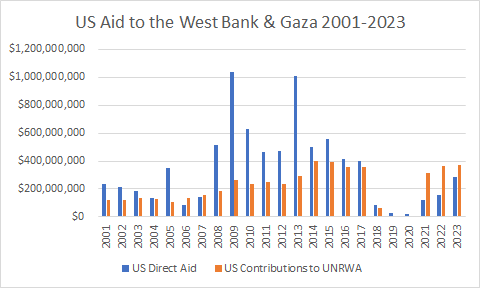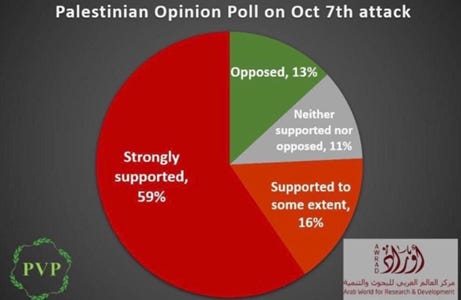In November of 2023 an idea was floated to send one or both of the US Navy’s two hospital ships into the eastern Mediterranean Sea to provide humanitarian relief to the Palestinians during the ongoing war in Gaza. Shockingly, this was the notion of Admiral (Ret.) James Stavridis, former NATO Supreme Allied Commander Europe, and former Dean of the Fletcher School of Law and Diplomacy at Tufts University. The crux of his argument was to “bring… US soft power to the war torn area.” One might be forgiven for thinking the US had been a spectator in the conflict between Israel and the Palestinians based on the article. Unfortunately, the opposite is the case. The US has invested heavily in soft power where the Palestinian people are concerned. Not only has that investment failed to achieve results, but in fact, it seems to have exacerbated the conflict.
This type of reflexive humanitarian thinking is worth addressing. First, because it occurs at very senior levels of the US military and diplomatic corps. Second, while the sentiment to “help” in a crisis is laudable, that instinctive reaction is being carried out without due deference to US strategic interests and on behalf of people who do not deserve our charity, i.e., those openly clamoring for the killing of Americans and/or our allies. If American money is to be sent abroad, it should be sent in service to American interests.
To understand the depth of this particular failure some numbers are helpful. According to both the American State Department and the Congressional Research Service the United States has spent approximately $13 billion on aid to Palestinians in Gaza and the West Bank since 2001. This includes US direct aid as well as US contributions to the United Nations Relief and Works Agency for Palestine (UNRWA). It’s important to keep in mind these are only US contributions, additional billions have been allocated from a collection of other nations in the hopes of addressing the ongoing plight of the Palestinians.
In exchange the US has received a series of low-level conflicts between Israel and the Palestinians, failed peace initiatives, ceasefire violations, the election of a designated terrorist group to administer Gaza, and periods of open warfare such as the one we are now all witnessing.
The UNRWA has for years been accused of promoting antisemitism, glorifying terrorism, and advocating for the destruction of Israel and its people. As the latest round of fighting continues, it is now fending off accusations from Israeli journalists that its employees may have participated in holding Israelis hostage for Hamas. The UNRWA has received almost $5 billion in US tax dollars since 2001. It was conspicuously denied funding for two years under the Trump administration (2019 and 2020) as a result of its alleged misconduct. President Biden restored funding in 2021 to the tune of $318 million, which increased to $364M and $371M in 2022 and 2023 respectively.
The average Palestinian is, by all available data, highly radicalized. The reason for this can be, and is, debated at length between proponents for either side of the conflict and is immaterial to this discussion. The question must be whether pumping billions of dollars into a highly radicalized society is a good idea. History indicates it is not. In 2006 Hamas was given an electoral majority to govern by the Palestinians of Gaza. Hamas subsequently purged its opposition, suspended elections, and committed to waging war on Israel. They’ve made good on this promise over the past 17 years. Most recently they’ve highlighted how international aid is used to fuel their war effort and the lengths they will go to to achieve their aims.
Broadly, this is supported by the Palestinians of Gaza and the West Bank. Two Palestinian polling firms have done prominent mid-war polls among the Palestinian population; the Arab World for Research and Development and the Palestinian Center for Policy and Survey Research. The results speak for themselves. The AWRAD poll conducted from Oct. 31 to Nov. 7 reported 75% support for the Oct. 7 attacks. The PCPSR poll conducted from Nov. 22 to Dec. 2 asked if Hamas was correct to launch the Oct. 7 attack, given the Israeli response. 72% of respondents said it was the correct course; 82% in the West Bank and 57% in Gaza. The October 7 attack boasts more support among Palestinians than any elected leader enjoys among their constituents in Western democracies. It’s not even close.
This is not a population to whom the United States, under President Biden’s emergency funding request, should be giving a portion of $9.2 billion more taxpayer dollars. We’ve already seen how our money is used and there is no logical reason to suppose additional funding will be treated any differently by a population that proudly professes its commitment to the annihilation of Israel. Funding both sides of a war in which the US has a vested interest in the outcome is positively lunatic.
But, you might ask, why would you oppose sending hospital ships to assist in alleviating civilian suffering? The better question, in my view, is why should the United States risk its vessels and its personnel to save the Palestinians from a war they wanted, and still want, according to the available data? In my view, we shouldn’t.
Adm. Stavridis suggests positioning either the USS Mercy, USS Comfort, or both in the region to assist in alleviating the local strain on medical facilities. The vessels could position themselves offshore and use boats or helicopters to ferry patients to and from shore. While he acknowledges the possibility of a missile attack on the vessels, he blithely dismisses it with the assurance that the Israeli and American navies can provide sufficient escort. There are several problems with this notion.
First, the USN has a grand total of two hospital ships, both of the Mercy-class, in our entire fleet. Two. They’re converted San Clemente-class supertankers built in the 1970s and retrofitted in the mid-1980s for their current role. USS Mercy (then SS Worth) took 13 months to build while her sister ship USS Comfort (then SS Rose City) was completed in 9 months. Both then underwent a 35 month refit for $208M per ship. When operating with a full complement they each carry a crew of almost 1300. The loss of one or both of these vessels would be a major blow to US naval operations capability globally and the loss of personnel, many of them highly specialized in their medical fields, would be more serious still. The US Navy was 7,000 sailors short of its recruitment goals last year, and given current shipbuilding issues it would certainly take years to replace even one of our hospital ships with a newly built unit.
Second, and Adm. Stavridis can be forgiven for this point as he penned his opinion piece before Houthi terrorists ramped up their missile attacks, this mission would take vital escorts away from safeguarding merchant traffic in the Red Sea. The Houthi missile and drone attacks on commercial shipping are currently a major concern for global trade and showcase the degree to which Iran has equipped some of its proxies. Hezbollah, which is reputed to have a vast missile arsenal at its command, must therefore be considered to have at least similar capability, perhaps in even greater quantity than the Houthis. The temptation to attempt to destroy vital US assets in the Mediterranean might prompt the Lebanon-based terror group into an open attack. Either on their own or in conjunction with other Iranian allied groups in the region.
Third, the ability to differentiate civilians from Hamas fighters is one the Israeli ground forces continue to struggle with. Paperwork and other credentials can be forged, and the prospect of a person having no credentials at all to verify their status as a civilian given the level of destruction in Gaza is entirely plausible on its own. The threat of infiltration to these hospital ships and the ferrying helicopters and small boats, or the detonation of a suicide explosive, is a genuine one. Hamas, and Palestinian terror groups more broadly, are notorious for their use of this tactic and would likely welcome the opportunity to inflict a high-profile attack on American military personnel with the possibility of significant casualties. To say nothing of the more conventional surface-to-air or shore-to-ship threat posed by Hamas militants still operating in and around Gaza to both US helicopters and small boats. The risk is simply untenable.
The cold facts of the matter are that America has tried soft power with respect to the Palestinians. We have given over $13 billion in aid, we have supported peace deals, and we have argued for Israeli restraint during previous periods of hostility. All of this has failed. Throwing good money after bad and risking critical US assets and their personnel on some quixotic notion that this time will be different, is pure folly. It is also an unconscionable risk to the sailors who may be killed or injured carrying it out. It’s time to let Israeli hard power have a turn and for the United States to keep well out of the “humanitarian” game.
[i] Data collected from:
The Congressional Research Service’s report: “The Palestinians: Background and US Relations”
https://crsreports.congress.gov/product/pdf/RL/RL34074
The US State Department’s reporting of UNRWA Assistance for 2002.
https://2001-2009.state.gov/r/pa/prs/ps/2002/13688.htm
The Washington Posts reporting of UNRWA contributions for 2023
https://www.washingtonpost.com/business/2023/11/11/unrwa-gaza-humanitarian-aid-congress/
ForeignAssistance.gov’s tracking chart for US aid to Gaza and the West Bank
https://www.foreignassistance.gov/cd/west-bank-gaza/




